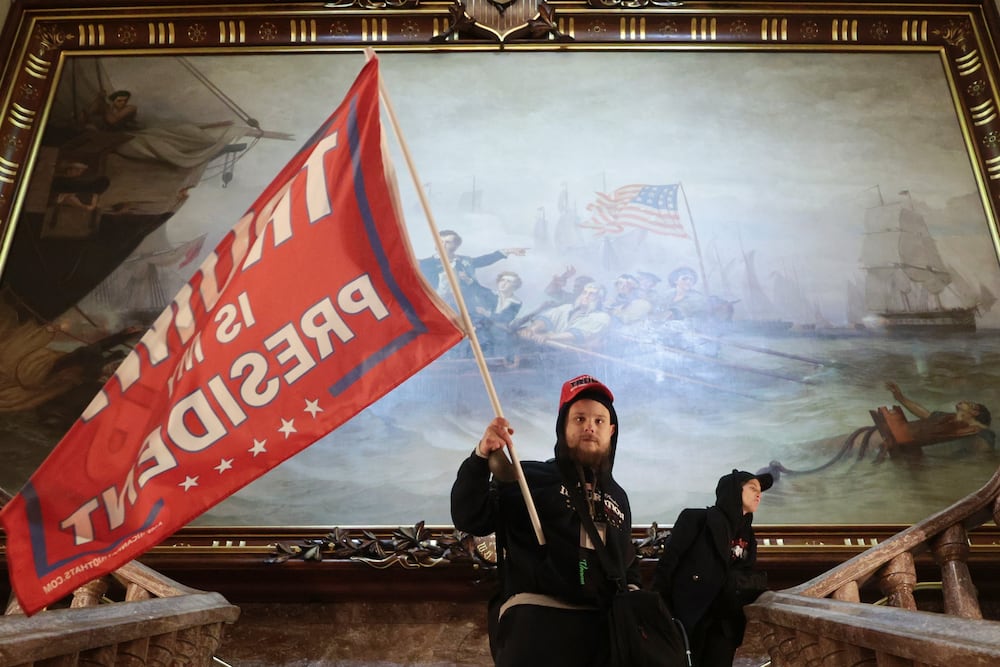The six-hour assault on Congress by supporters of Donald Trump left a trail of destruction in their wake.
Marble portraits and statues sprayed with a corrosive gas;
the bust of Zachary Taylor, the 12th president of the United States, stained by a red liquid, a vandalized photograph of the recently deceased activist and African American Congressman John Lewis, computers of missing legislators and documents of the Department of Justice scattered on the ground.
Among the rubble left by the anger of the supporters of the US president for a nonexistent electoral fraud have also been museum treasures of the future.
Commissioners of the Smithsonian Institution have collected the objects found after the revolt on Wednesday, January 6.
Frank Blazich, curator of the Museum of American History, has been one of the specialists who found historical value among the traces left by the mob.
The day after the assault, Blazich toured the National Mall, the huge open-air esplanade that leads to the Capitol.
After three hours going through garbage cans and lifting objects from the ground, he gathered more than thirty posters, flags and stickers in favor of the insurrection.
Among these objects is a plaque that says “
Off with their heads-stop the steal
” (Cut heads, stop the theft).
This selection is in addition to others purchased by the institution, such as Trump election campaign clothing with the slogan
Keep America Great
and pamphlets.
"What some call junk I call history," wrote Blazich, an air force veteran who majored in military history for one of the Smithsonian centers.
The division he works for gathers material on political history in the United States and the military.
The collection includes objects from the Seven Years' War (1756-1763) and other artifacts and materials that survive to this day.
His team is interested in democratic changes in the United States, political rights, ideological clash, and the role of parties.
In short, everything has undergone shock therapy during Trump's four years in power.
The United States is still trying to digest the images of the violent far-right inside the Capitol, which left five dead.
The media and analysts agree that it was a historical event that clouds the immediate future and that has made Washington a city besieged by the military and police, fraught with tension.
In this setting, unique in recent memory of the investiture, historians move, documenting an increasingly ephemeral present due to the succession of numerous events.
"The electoral stage has left us notable cases of pain and the possibility of engaging in the process of reckoning with the past in order to shape the future," said Anthea Hartig, director of the Museum of American History, shortly after the assault. to Congress.
As an example of the value of objects from the past, Hartig recalled one of the most valuable pieces in the collection: the flag that celebrated the triumph of Thomas Jefferson and the peaceful transfer of power after the disputed elections of 1800, where the President John Adams lost after a tie in Electoral College votes.
The curators' work will help future generations to remember and put the violent episode in context.
During this Administration, a team of specialists from the Smithsonian's Division of Political and Military History have also documented and collected ephemeral objects from the protests of the Black Lives Matter movement that occurred a few meters from the White House, the 2017 women's march and 2018 and the demonstrations of the
dreamers
(young immigrants) at the doors of the Supreme Court, in 2020.
But a collection of modern American political history would be incomplete without reflecting the deep imprint left by conservatism and the far right in recent years.
The Smithsonian's collections include items from the many anti-abortion demonstrations and rallies of the Tea Party, the group of ultraconservatives that toured several cities in 2010 to prepare the breeding ground for Trumpism.
A chapter that will begin to close next Wednesday, January 20.
Captain America against the insurgents
The images inside the Capitol seemed to belong to a Marvel fiction. Several of the rebels, who believed to free their country from electoral fraud, wore the colors of the superhero Captain America. One even carried a shield like that of the famous character created in 1941 by Jack Kirby and Joe Simon, two Jews who fought in World War II. When Neal Kirby, Jack's 72-year-old son, saw the images of the assault his stomach turned. "I was horrified," he wrote in a statement. "Captain America is the antithesis of Donald Trump ... If Trump had the qualities and character of the captain, the White House would be a shining symbol of truth and integrity and not a sewer that fumes lies and hypocrisy," concluded Kirby. However, the most patriotic hero in the comic book universe does have coincidences with the outgoing president, such as the policy of "America first" (America First). In 2016, already in the Trump Administration, the writers of the comic series 'Secret Empire' turned the famous character for 15 months into a fascist agent of Hydra, the Nazi organization against which Captain America fought for decades.

